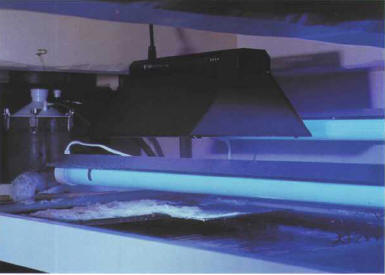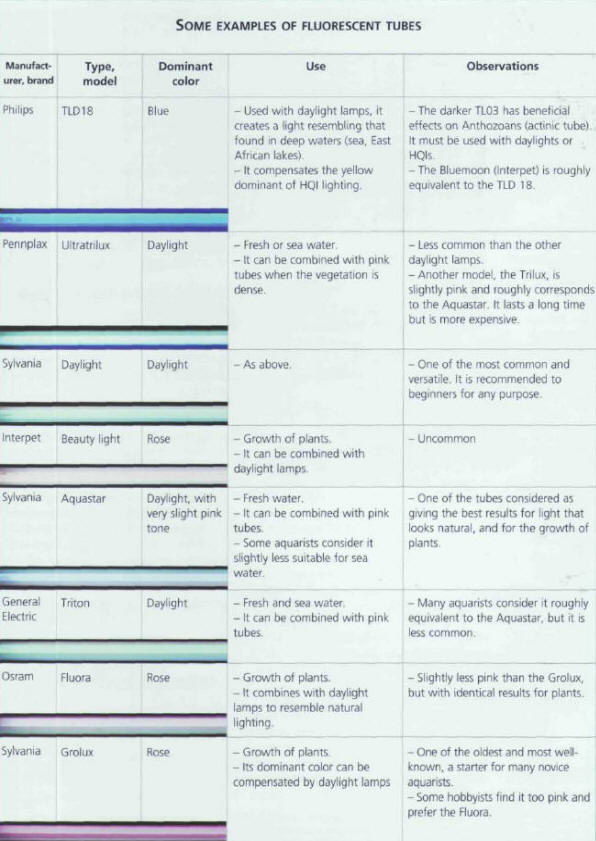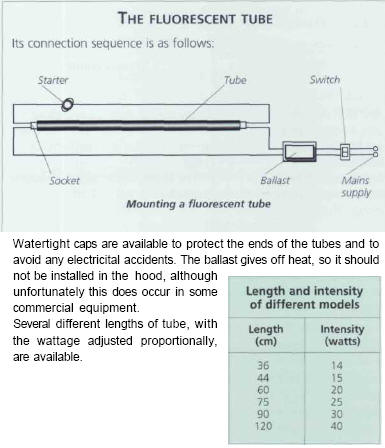LIGHT SOURCES
A whole host of light sources, each with its own distinguishing features, is
available to aquarists.
Incandescent lamps
These are what we use from day to day in our homes, but they are absolutely out
of the question in aquariums: the quality of light is poor, and this type of bulb
gives off too much heat.
Fluorescent tubes
Incorrectly known as neons, these tubes contain a gas that turns fluorescent
under the action of an electrical discharge. They give off little heat and are available
in various lengths and intensities. They last for 3,000-4,000 hours, or around a
year. The quality of the illumination decreases over the course of time, however,
and this can be clearly seen if an old tube is replaced by a new one. For this reason,
never change all the tubes in a tank at the same time, as plants may be traumatized
by this abrupt change in the intensity of the light. A used tube can be recognized
by its black or dark ends. Fluorescent tubes come in various colors: firstly, the
cold white or industrial white tubes, which are to be avoided, and the daylight
tubes. The latter approximate sunlight the most closely and provide well-balanced
lighting. Also available are colored tubes with a variety of dominants, including
the tubes with a pink dominant used in horticulture, which are particularly effective
for the growth of plants, as they mainly emit blue and red rays, which are trapped
by plants and used in the photosynthesis process. Some aquarists do not appreciate
their somewhat unnatural color, which tends to exaggerate the red and blue tones
of fish. Sometimes tubes with a blue dominant are combined with white to create
a light reminiscent of that found in deep waters. Such tubes are beneficial for
corals and other animals from the same group, and have therefore acquired the name
of actinia tubes.

Some blue fluorescent tubes can compensate the dominant
yellow of HQI bulbs, resulting in a balanced lighting which is as pleasing to the
inhabitants of the aquarium as it is to the eye of the beholder.
Other colors are available, but they are less common. It is sometimes possible
to find tubes with a yellow dominant, which are combined with blue tubes to achieve
a more balanced light.

A fluorescent tube is not plugged directly into the mains: you must insert a
transformer, the ballast, and a starter which produces the electrical discharges
required. If you buy a well equipped aquarium, or one with a lighting hood, the
tubes will be provided. This does not always mean that you can rest easy, as the
intensity of the pre-installed tubes is sometimes insufficient.

Halogen lamps
The tungsten filament of incandescent bulbs is here replaced by another metal,
which prevents them from turning black. These lamps can be equipped with a rheostat,
but they are generally little used by hobbyists.
Discharge lamps
An electrical discharge between two electrodes vaporizes a gas, such as mercury
or sodium vapor - which emits an intense light. These lamps have a slight yellow
dominant, imperceptible to the human eye, which is compensated by a blue fluorescent
tube. They heat up and consume more electricity than fluorescent tubes. Some, known
as HQI daylight, are prized by aquarists, but they are expensive and impractical
for normal tanks. They are mainly used in seawater aquariums over 0.5 m in height,
as they help to acclimatize Anthozoans with Zooxanthellae.
Watertight caps are available to protect the ends of the tubes and to avoid any
electricital accidents. The ballast gives off heat, so it should not be installed
in the hood, although unfortunately this does occur in some commercial equipment.
Several different lengths of tube, with the wattage adjusted proportionally, are
available.
The hood
Whatever type of light source you choose, it requires a support: this is the
hood. Fluorescent tubes must be included in a hood, out of reach of splashed water.
It is often protected by a pane of glass but. if this is not the case, the aquarium
lid serves the same function. To avoid any loss of light, any partition between
the lighting and the water must maintain its shape when exposed to heat, as well
as being transparent and. above all, clean. Glass is therefore the ideal material.
Loss of light in the hood can be substantial, sometimes up to 20-30%. There are
a few tricks which can resolve this problem, the main principle being to reflect
as much light as possible towards the water. You can, therefore, line the inside
of the hood with the smoothest possible aluminum foil, coat it with white or metallic
paint, or make one or several semicircular metallic reflectors to fit round the
tubes. Some galleries on the market use one of the last two techniques. As the intensity
of the light decreases when it gets further away from its source, it is important
for the latter to be as close to the water as possible. It should not be any closer
than 5-8 cm, for technical and safety reasons, but even with these restrictions
the illumination can be satisfactory. (This reduction in intensity has been taken
into account in the calculations for the strength of the lighting and the number
of fluorescent tubes.)
|